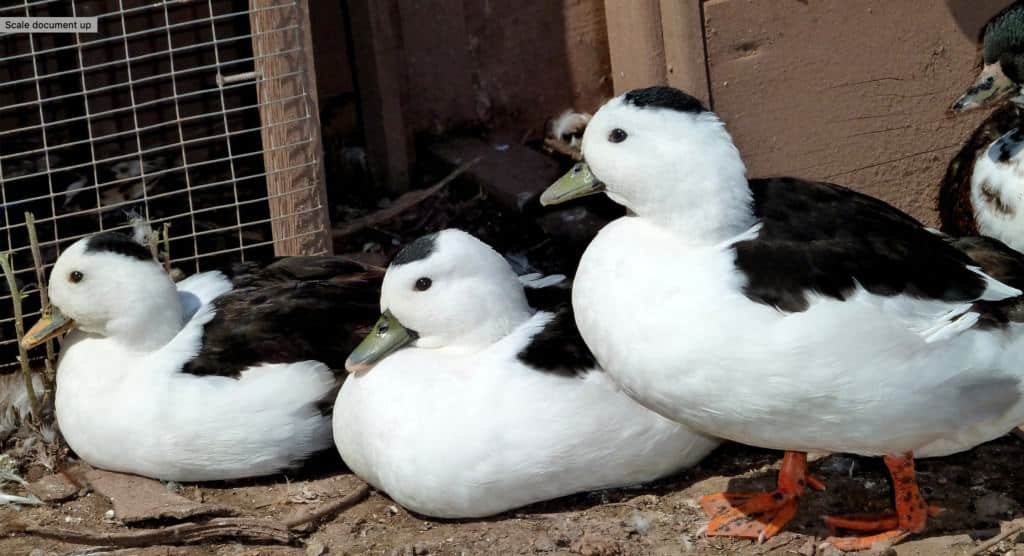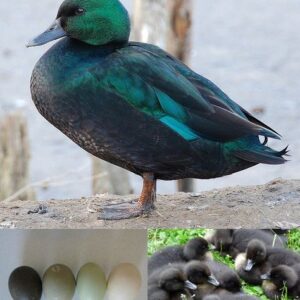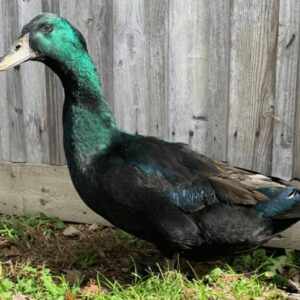Call Ducks are a small, charming breed of domestic duck (Anas platyrhynchos domesticus) known for their petite size, lively personalities, and distinctive, loud quacks. Originally bred in Europe as decoy ducks for hunting, Call Ducks have evolved into popular ornamental and pet ducks, adored for their cuteness and playful demeanor. Their manageable size and friendly nature make them a favorite among backyard poultry keepers, hobbyists, and waterfowl enthusiasts.
Physical Characteristics
Call Ducks are renowned for their small size and adorable appearance, making them one of the most visually appealing duck breeds.
- Size: They are the smallest domesticated duck breed, with drakes (males) typically weighing around 1–1.5 pounds (450–700 grams) and hens (females) slightly smaller at 1–1.3 pounds (450–600 grams).
- Plumage: Call Ducks come in a wide range of colors and patterns, including Mallard, White, Gray, Buff, Blue Fawn, and Pastel. Their feathers are smooth and glossy, enhancing their visual appeal.
- Body Shape: They have a compact, rounded body with a short neck and an upright stance, giving them a playful, “toy-like” appearance.
- Bill and Legs: Their bills are short and broad, contributing to their charming expression. The legs are short and positioned closer to the back of the body, emphasizing their round shape.
- Eyes: Large, dark eyes add to their endearing look, making them particularly attractive to bird lovers.
Behavior and Temperament
Call Ducks are known for their lively, social, and friendly personalities.
- Loud Quacking: One of their most distinctive traits is their loud, high-pitched quack. Hens are particularly vocal and were historically bred to attract wild ducks during hunting. While their quacking can be entertaining, it may not be suitable for noise-sensitive environments.
- Playful and Energetic: Call Ducks are active birds that enjoy foraging, swimming, and exploring their surroundings. They are often seen playing in water or interacting with their owners.
- Social Creatures: They thrive in groups and enjoy the company of other ducks or even humans. Their friendly disposition makes them excellent pets.
- Intelligent and Curious: Call Ducks are intelligent and curious, often forming bonds with their caretakers. They can learn routines and may even respond to their names.
Egg Production
Although Call Ducks are primarily kept as ornamental or pet birds, they are capable of laying eggs.
- Egg Output: Hens typically lay 25–75 eggs per year, depending on their care and environment.
- Egg Size and Color: The eggs are small, white, and sometimes have a slight tint. They are comparable to bantam chicken eggs in size.
- Broodiness: Call Ducks are known for their strong maternal instincts and will readily go broody, often making excellent mothers.
Habitat and Care
Call Ducks are hardy and adaptable but require proper care to thrive.
- Housing: They need a secure, predator-proof enclosure to keep them safe at night. Their small size makes them more vulnerable to predators than larger duck breeds.
- Water Access: Like all ducks, Call Ducks benefit from access to water for swimming and preening. A small pond or kiddie pool is sufficient for their needs.
- Space Requirements: While they are small and don’t require much space, they still need room to forage and exercise. A clean, dry area with access to grass or other forage is ideal.
- Diet: Call Ducks thrive on a balanced diet of commercial waterfowl feed, supplemented with fresh greens and grains. They also enjoy foraging for insects and small invertebrates.
History and Origin
The Call Duck has a fascinating history rooted in its use as a hunting aid.
- Origins: The breed is believed to have originated in the Netherlands, where it was initially bred to act as a “decoy” to lure wild ducks into hunting traps.
- Spread to England: Call Ducks were introduced to England in the 19th century and became popular as ornamental birds and pets.
- Exhibition Ducks: Over time, selective breeding enhanced their small size, loud quack, and appealing appearance, making them popular show birds.
- Recognition: They were officially recognized by poultry associations, including the American Poultry Association (APA), as an ornamental breed.
Conservation and Popularity
Call Ducks are widely appreciated and actively bred, though their small size and specific needs make them less common than larger duck breeds.
- Exhibition Value: They are a popular choice for poultry shows due to their stunning appearance and wide variety of colors.
- Pet Popularity: Their manageable size and friendly nature have made them highly sought after as pets.
- Conservation: While not at risk, maintaining the genetic diversity of Call Ducks is important, and many breeders focus on preserving their unique traits.
Uses and Benefits
Call Ducks are versatile birds with several uses, making them a valuable addition to any flock.
- Ornamental Value: Their small size, wide range of colors, and playful behavior make them excellent ornamental birds for ponds and gardens.
- Pets: Their friendly and sociable nature makes them delightful pets, especially for families and hobbyists.
- Egg Production: While not prolific layers, their eggs are a bonus for keepers.
- Exhibition: Call Ducks are highly prized in poultry shows for their beauty and unique traits.
Challenges of Keeping Call Ducks
While Call Ducks are delightful to own, there are a few challenges to consider:
- Noise: Their loud quacking may not be suitable for urban or suburban settings.
- Predator Vulnerability: Their small size makes them more susceptible to predators, requiring secure housing.
- Specialized Care: They need more attention to diet, shelter, and water than some other breeds.
Conclusion
The Call Duck is a delightful breed that combines beauty, intelligence, and charm. Its small size, friendly disposition, and ornamental value make it an excellent choice for hobbyists, backyard poultry enthusiasts, and pet owners. Whether gracing a pond, participating in a poultry show, or bringing joy as a companion, the Call Duck is a versatile and captivating addition to any flock.










Reviews
There are no reviews yet.